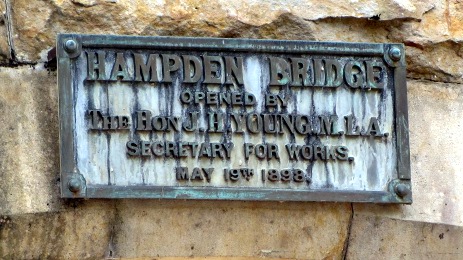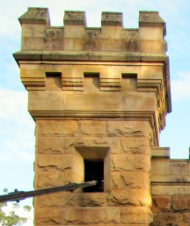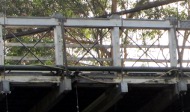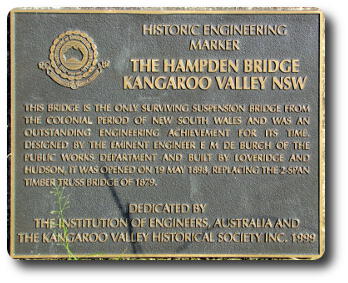
The following is from the Kangaroo Valley Historic Walk display board at Hampden Bridge.
Beautiful and RareThis bridge is Australia's last surviving wooden suspension bridge of the 19th Century and one of the best known in New South Wales. Not only has it enormous aesthetic appeal (National Trust), but it is considered very rare because the majority of the structure is original.
Investment and Local MaterialsCompleted in 1898 at a cost of 6,985 pounds, the bridge was a significant financial commitment when considering that the whole of Cambewarra Shire's annual council budget was 1,774 pounds (1908). The sandstone was taken from the quarry (within the Pioneer Museum grounds) and timber selected locally. Only the 28 steel cables were sourced outside the area.
Naming and CelebrationThe bridge is named after the Governor of New South Wales, Lord Hampden (1895 - 1899) who said "I should be very pleased to have my name connected with such a beautiful locality". On 19th May 1898, 400 people attended the opening ceremony which was followed by a banquet in the National Hall (destroyed by floods).
Supplying Sydney and the ColonyOriginally designed for horse and cart plus a Traction Engine (weight 14 tonnes) this bridge provided an important link between the Southern Highlands and South Coast, albeit at a leisurely pace, for in 1908 Council decided that the speed of motor cars within town boundaries and on the mountain passes be not more than 4 mph. Local produce (timber, tallow and hides) was taken to the port of Bombo where the small coastal steamers Lapwing and Dolphin sailed to Sydney and its markets.
National and Community ValueIn 2002 the National Trust listed the bridge as an industrial heritage site because of its significant technical achievement and original surviving features. The bridge is revered throughout the Shoalhaven as a symbold of Australia's early history and an icon of this historic pioneering community. |
 |
|
The towers made of hand carved local sandstone resemble the turrets
on an English mediaeval castle, made by the colony's principal
stonemasons Loveridge and Hudson
Original 28 high tensile steel cables which are 138 metres long, manufactured in England and have a Guranteed Minimum Breaking Load of 70 tonnes, although they were proof testing in Sydney to 89 tonnes. | |
 | |
|
Mighty native timbers span the 77 metres with the beams of 360 mm
by 250 mm and side trusses 250 mm by 200 mm.
|
 The inscription on the plaque reads:-
The inscription on the plaque reads:-
The Hampden Bridge
Kangaroo Valley NSW
This bridge is the only surviving suspension bridge from the colonial period of New South Wales and was an outstanding engineering achievement for its time. Designed by the eminent engineer E. M. De Burgh of the Public Works Department and built by Loveridge and Hudson, it was opened on 19 May 1898, replacing the 2 span timber truss bridge of 1879.
Dedicated by The Institute of Engineers, Australia and The Kangaroo Valley Historical Society Inc 1999
Hampden Bridge
Kangaroo Valley
This 77m long suspension bridge was designed by E. M. De Burgh, Assistant Engineer for Bridges, NSW Department of Public Works and built by Loveridge and Hudson of Bowral, using local sandstone. It was officially opened on 19 May 1898 by Hon. J. H. Young, MLA, Minister for Works, and named after the Governor, Lord Hampden.
Erected to celebrate Australia's Bicentenary in 1988 by the Department of Main Roads and the National Roads and Motorists Association (N.R.M.A.)